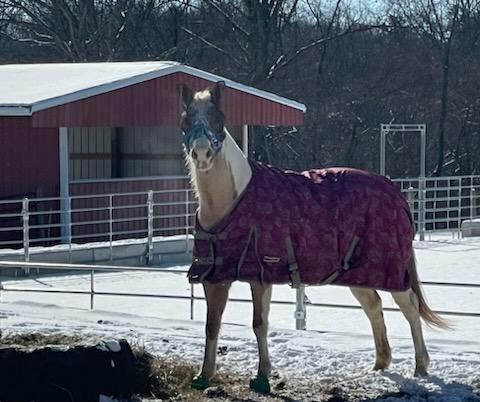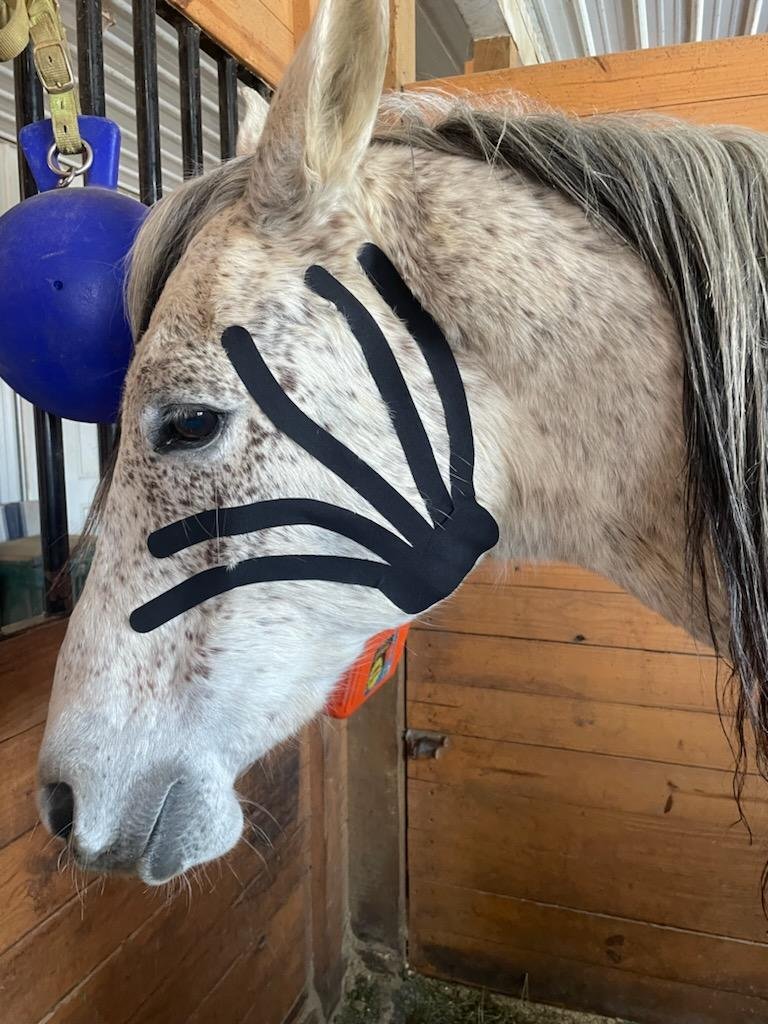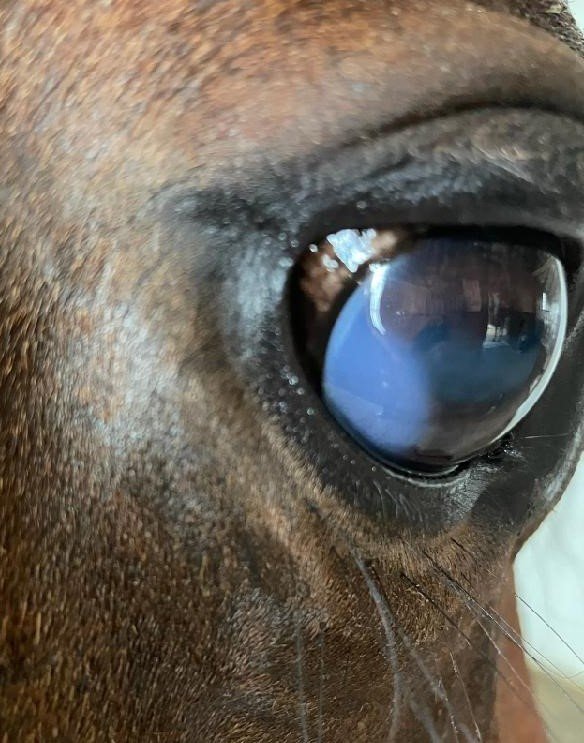Protecting Your Horses Eyes: Prevention and Remedies
Equine eye injuries are fairly common and should always be taken seriously. Vision is important to a horse and affects their behavior.
Horses are prone to eye problems in part because their eyes are large and located on the side of their head.
Fun Fact: The horse has one of the largest eye sizes of any land mammal. Moose's eyes are bigger!
Eye Anatomy
Like other mammals, the horse’s eyeball is made up of a retina, uvea, and cornea. Behind these parts which take in information is the optic nerve. The optic nerve sends the information to the brain for the horse to “see”.
The adnexa are the outside layers containing the eyelids and the lacrimal apparatus (tear ducts).
The horse has a large eye socket which is called the orbit. This helps protect the eye from outside harm.
Horses can develop glaucoma and cataracts just like humans. Unlike humans, horses exhibit “eyeshine” which is the reflection of light off a thin membrane called the tapetum. The tapetum occurs in several animal species and allows them to see better in the dark.
Fun Fact: Horses have a third eyelid (nictitating membrane) that helps protect the cornea.
Photo credit: Merck Veterinary Manual
What Causes Eye Injuries In Horses?
Foreign Object
Sunlight
Ulcer
Uveitis
Impact
Fencing
Symptoms of An Eye Injury
If you notice one of these symptoms it may mean an eye injury or disease. Take a closer look and call your vet for any serious problems.
Swelling of the eye or eyelid
Eyes that look cloudy
Bloodshot eyes - the white of the eye is pink or bloody-looking
Persistent yellow or green discharge or excessive tearing
One or both eyes are closed and they won’t try to open them
Squinting or turning from the sun
1. Foreign Object
Any number of things can get into your horse’s eyes. A piece of straw or shavings, a twig, or burr.
If the horse doesn’t naturally remove the object by blinking or tearing then you may need to gently remove it for them. Use a sterile eyewash or saline solution made for humans when rinsing contact lenses. You can also purchase an animal eye rinse at your local feed store.
If an object is lodged in the eye it’s time to call the vet.
This may lead to a corneal ulcer and you should keep your eye on it. (pun intended!)
Keeping fields mowed, removing brush, and making sure your bedding is not dusty will help.
2. Sunlight
Sunlight can be very hard on your horse’s eyes. Both the intense sun of summer and the sun reflected off the snow in winter.
Some horses are more sensitive to the sun’s glare. Think about which direction their paddock faces, do they have reflection off a metal barn, or from the snow?
At Cork N Mane we recently had an issue where Henry was outside in the snow and had an obvious sensitivity to the sun reflecting off the snow. His eyes were sunburned and painful.
A great way to prevent this is to have your horse wear a fly mask. In winter they can function as a pair of netted sunglasses.
Henry received a Taping Treatment after sunburn to the eyes to provide comfort and give circulation assistance. Photo by Susan Dickinson.
3. Corneal Edema
Corneal edema is typically caused by a trauma to the eye and has the nickname “blue eye”. You can see the blueish shadow in the picture below of Doyle.
The cornea of the eye is typically transparent. When the eye experiences trauma then it swells which causes the eye to look blue or cloudy.
You will need to contact your vet. Topical antibiotics and anti-inflammatories may be prescribed.
4. Corneal Ulcer
An ulcer in the eye is one of the more common eye ailments you may experience. It is caused by a break in the surface layer of the cornea. Basically a scratch on the eye.
Signs of a Corneal Ulcer
Redness
Tearing
Squinting
Cornea may have opaque spots
An ulcer requires veterinary care. Your vet can use a process called fluorescein staining to examine the ulcer. Some ulcers are easily treated with antibiotic drops and/or anti-inflammatories. A small percentage of eye ulcers may require surgery.
Want To stand Out? We can digitalize your logo and place it on
clothing and merch.
5. Uveitis
Uveitis is an inflammation within the eye that is also referred to as “Moon Blindness”. It is an infection that infects a layer of delicate tissue between the cornea and the retina.
It is a serious condition that can lead to Equine Recurrent Uveitis (ERU).
ERU is an autoimmune disease that can lead to blindness. Symptoms include painful eyes, squinting tearing, and inflammation around the eye. Since any form of uveitis is painful you may notice behavioral changes such as grumpiness or spooking easily.
It tends to impact Appalossa’s and Warmbloods at a higher rate.
There is no cure for ERU so treatment involves alleviating the symptoms. Anti-inflammatories and eye drops are typically prescribed.
Keeping your horse out of the sun and wind will help. Wearing a fly mask can also help protect the eyes.
Complementary therapies have proven to offer relief from the symptoms. Supplements, chiropractic work, and taping have all had positive results. Work with your Complimentary Therapist to develop a plan for your horse.
6. Impact
Equines tend to move forward quickly with their heads reaching forward. It’s common for them to become frightened and run into something causing a blunt force to the face.
Their eye or the surrounding area may become, swollen, inflamed, or bruised.
This is another situation where taping can benefit your horse.
Preventing Eye Problems
There are many steps you can take to prevent eye problems:
Check for any loose boards or tree limbs that they may inadvertently run into
Work to control flies and other insects
Keep a nice thick layer of bedding in the stall to reduce dust
Using a Fly Mask - ALWAYS!
We recently needed to take Doyle to an equine ophthalmologist after he hit his head. Dr. Stephanie Bell of Hagyard Equine Medical Institute gave him a thorough exam and diagnosed him with corneal edema.
Dr. Bell told us that she recommends that horses wear a fly mask at all times. Fly masks help with flies but they also help with environmental conditions such as dust and pollen. In winter they prevent snow glare.
We decided to use Professional Choice fly masks which are reasonably priced and have large mesh eye holes so the horses can continue to see well in all directions. Photo by Susan Dickinson.
How Well Do Horses See?
Horses see quite well. They do see colors and have a sense of depth perception.
They have excellent peripheral vision. When the horse is facing forward they can see an arc of 340°. This allows the horse to easily spot predators.
Compared to humans they see less of a range of colors and not as much focus.
Fun Fact: Approximately 1/3 of domestic horses tend to have myopia (near-sightedness), with few being far-sighted. Wild horses, however, tend to be far-sighted according to Thomas Gore DVM author of the Horse Owners Veterinary Handbook.
Example of Horse Vision
A representation of how a horse possibly sees a red or a green apple (bottom) compared to how red or green apples are usually seen by most humans (top)
The simulation was performed using the vischeck website (www.vischeck.com) with an algorithm originally developed by Brettel et al., 1994. Original images of apples are taken from the Wikipedia commons: Author: Alex Wade
Author, Ame Vanorio does our blog and social media. She is the mother of rescue horse, Rocket.










